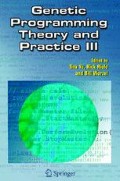Abstract
Bloat is a common and well studied problem in genetic programming. Size and depth limits are often used to combat bloat, but to date there has been little detailed exploration of the effects and biases of such limits. In this paper we present empirical analysis of the effects of size and depth limits on binary tree genetic programs. We find that size limits control population average size in much the same way as depth limits do. Our data suggests, however that size limits provide finer and more reliable control than depth limits, which has less of an impact upon tree shapes.
Access this chapter
Tax calculation will be finalised at checkout
Purchases are for personal use only
Preview
Unable to display preview. Download preview PDF.
References
Daida, Jason M. (2003). What makes a problem GP-hard? A look at how structure affects content. In Riolo, Rick L. and Worzel, Bill, editors, Genetic Programming Theory and Practice, chapter 7, pages 99–118. Kluwer.
Daida, Jason M. and Hilss, Adam M. (2003). Identifying structural mechanisms in standard genetic programming. In Cantú-Paz, E. et al., editors, Genetic and Evolutionary Computation — GECCO-2003, volume 2724 of LNCS, pages 1639–1651, Chicago. Springer-Verlag.
Daida, Jason M., Hilss, Adam M., Ward, David J., and Long, Stephen L. (2005). Visualizing tree structures in genetic programming. Genetic Programming and Evolvable Machines, 6. Prepublication Date: 6 August 2004.
Gathercole, Chris and Ross, Peter (1996). An adverse interaction between crossover and restricted tree depth in genetic programming. In Koza, John R., Goldberg, David E., Fogel, David B., and Riolo, Rick L., editors, Genetic Programming 1996: Proceedings of the First Annual Conference, pages 291–296, Stanford University, CA, USA. MIT Press.
Koza, John R. (1992). Genetic Programming: On the Programming of Computers by Means of Natural Selection. MIT Press, Cambridge, MA, USA.
Koza, John R. (1994). Genetic Programming II: Automatic Discovery of Reusable Programs. MIT Press, Cambridge Massachusetts.
Langdon, W. B. and Poli, Riccardo (2002). Foundations of Genetic Programming. Springer-Verlag.
Luke, Sean and Panait, Liviu (2002). Lexicographic parsimony pressure. In Langdon, W. B. et al., editors, GECCO 2002: Proceedings of the Genetic and Evolutionary Computation Conference, pages 829–836, New York. Morgan Kaufmann Publishers.
McPhee, Nicholas Freitag, Jarvis, Alex, and Crane, Ellery Fussell (2004). On the strength of size limits in linear genetic programming. In Deb, Kalyanmoy et al., editors, Genetic and Evolutionary Computation — GECCO-2004, Part II, volume 3103 of Lecture Notes in Computer Science, pages 593–604, Seattle, WA, USA. Springer-Verlag.
McPhee, Nicholas Freitag and Miller, Justin Darwin (1995). Accurate replication in genetic programming. In Eshelman, L., editor, Genetic Algorithms: Proceedings of the Sixth International Conference (ICGA95), pages 303–309, Pittsburgh, PA, USA. Morgan Kaufmann.
McPhee, Nicholas Freitag and Poli, Riccardo (2002). Using schema theory to explore interactions of multiple operators. In Langdon, W. B. et al., editors, GECCO 2002: Proceedings of the Genetic and Evolutionary Computation Conference, pages 853–860, New York. Morgan Kaufmann Publishers.
Poli, Riccardo (2003). A simple but theoretically-motivated method to control bloatin genetic programming. In Ryan, C. and et al, editors, Proceedings of the Sixth European Conference on Genetic Programming (EuroGP-2003), volume 2610 of LNCS, pages 204–217, Essex, UK. Springer Verlag.
Poli, Riccardo and McPhee, Nicholas Freitag (2003). General schema theory for genetic programming with subtree-sw apping crossover: Part II. Evolutionary Computation, 11(2).
Rowe, Jon E. and McPhee, Nicholas F. (2001). The effects of crossover and mutation operators on variable length linear structures. In Proceedings of the Genetic and Evolutionary Computation Conference (GECCO-2001), San Francisco, California, USA. Morgan Kaufmann.
Silva, Sara and Almeida, Jonas (2003). Dynamic maximum tree depth. In Cantú-Paz, E. et al., editors, Genetic and Evolutionary Computation — GECCO-2003, volume 2724 of LNCS, pages 1776–1787, Chicago. Springer-Verlag.
Author information
Authors and Affiliations
Editor information
Editors and Affiliations
Rights and permissions
Copyright information
© 2006 Springer Science+Business Media, Inc.
About this chapter
Cite this chapter
Crane, E.F., McPhee, N.F. (2006). The Effects of Size and Depth Limits on Tree Based Genetic Programming. In: Yu, T., Riolo, R., Worzel, B. (eds) Genetic Programming Theory and Practice III. Genetic Programming, vol 9. Springer, Boston, MA. https://doi.org/10.1007/0-387-28111-8_15
Download citation
DOI: https://doi.org/10.1007/0-387-28111-8_15
Publisher Name: Springer, Boston, MA
Print ISBN: 978-0-387-28110-0
Online ISBN: 978-0-387-28111-7
eBook Packages: Computer ScienceComputer Science (R0)

